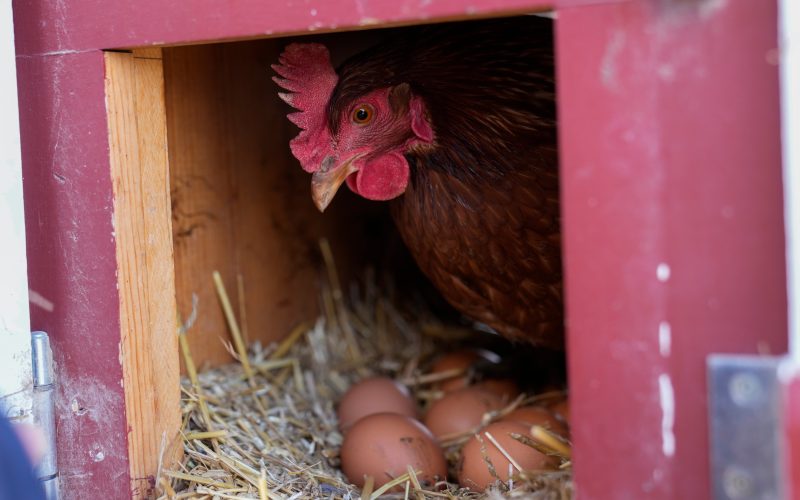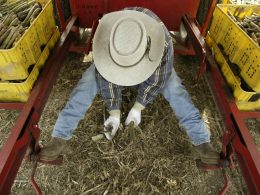On Friday, February 7, 2025, in Glenview, Illinois, a Red Star hen, a hybrid breed that produces enormous brown eggs, sits on eggs inside her coop at Historic Wagner Farm.AP’s Erin Hooley
LAS VEGAS In 2021, when egg prices were still comfortably below $2 per dozen, Nevada joined a number of other jurisdictions that were concerned about animal welfare in mandating cage-free eggs.
Four years later, the average price of a dozen eggs in the United States is about $5 due to the persistent avian flu. In an effort to help citizens at the checkout counter, Nevada drafted a law that the governor signed on Thursday, allowing the state to temporarily suspend the rule.
However, it is not quite that easy, which is why the other six states with similar laws—including Oregon and Washington—have been reluctant to adopt them thus far.
Nevada may have access to more eggs if the rule is loosened, but the availability of all eggs is still limited because, since the bird flu pandemic started in 2022, around 159 million birds have been killed to stop the virus’s spread. Whenever the virus is discovered, whole flocks are killed.
Since the farmers who collectively spent several billion dollars making the switch cannot simply return to raising chickens crammed together in enormous barns that they already spent the money to convert, it is unclear whether repealing cage-free laws will have a significant impact on egg prices, which have peaked at an average of $4.95 per dozen.
There would still be a high demand for cage-free eggs even if all the laws prohibiting them were repealed because large companies like McDonald’s and Sodexo are still determined to exclusively purchase such eggs.
According to agricultural economist Jada Thompson of the University of Arkansas, allowing all types of eggs to be sold in Nevada would somewhat lower prices there, but given the scarcity of supply, it might worsen pricing elsewhere.
Nevada tries to counter high egg prices
Even if California, Massachusetts, Washington, Oregon, Colorado, and Michigan don’t appear to be contemplating it, Nevada will give it a shot. Although cage-free legislation is already in place in Arizona, Rhode Island, and Utah, it won’t go into force for at least a few more years.
In order to advance the level of humane care of the animals, Democratic Assembly member Howard Watts III, who keeps hens in his backyard in Nevada, pushed for the 2021 measure. Egg prices have reached a record high due to the continuing avian flu outbreak in the United States, and cage-free eggs are typically significantly more costly.
Watts testified on Tuesday that this significant epidemic of animal sickness was one of the things that was not anticipated at the time. Therefore, in the case of a significant supply chain interruption, there was no regulatory flexibility to suspend those obligations.
The law’s 120-day suspension was passed Thursday by Republican Governor Joe Lombardo. According to Nevada Department of Agriculture spokesperson Ciara Ressel, it will take around a month before consumers notice a change at supermarkets.
Egg Works’ owner and main eggineer, Brad Burdsall, stated that he is now spending more than twice as much for a case of eggs as he did two years ago, when a case of fifteen dozen eggs cost $129. Until prices decrease, the eatery imposed a 50-cent premium each shelled egg.
The restaurant will have access to other egg sources thanks to the Nevada measure signed Thursday, and Bursdall says he hopes to remove the premium in the near future.
“I sincerely hope the governor looks closely at this cage-free initiative and decides to make it permanent,” he said.
The largest increase in egg costs since the country’s previous avian flu outbreak in 2015 occurred this month. Two years ago, when eggs were selling for an average of $4.82 per dozen, the previous high was reached.
In certain regions, the average costs conceal the severity of the situation. These days, some Californians are spending $12.99 on a dozen, which is more than a dollars an egg. To assist those who cannot buy a dozen eggs, some stores in New York have even begun to sell bundles of three.
A minority of eggs are produced on cage-free farms
The concern with the cage-free requirements is that only about 121 million of the 304 million chickens laying eggs nationwide are raised on cage-free farms, so the supply is limited.
Many of the eggs those hens produce are promised to restaurant chains like McDonald s and Panera, food service giants like Sodexo and Aramark and grocers under long-term contracts that help keep prices down. However, supermarkets can lose money on eggs by offering them cheaply in an attempt to draw customers in, even when they actually have to pay more.
The number of cage-free chickens has steadily increased in recent years because of the laws and the pressure from the companies buying eggs, increasing exponentially from just 38 million at the start of 2017. However, the supply is limited since more consumers are demanding those eggs, and the United Egg Producers trade association estimates that at least 226 million cage-free chickens would be needed to accommodate all of the demand.
Prior to the start of the bird flu outbreak, there were more than 330 million hens in the country.
Up until the current bird flu outbreak started in early 2022, prices remained mostly between $1.40 and $2 a dozen, with the exception of the typical seasonal price jumps around Easter and Thanksgiving, even as more egg farmers switched to cage-free settings over the previous ten years.
There will be fewer eggs available to replace the lost eggs if cage-free farms are severely affected by bird flu outbreaks. For instance, more than 3 million of the almost 47 million birds killed since the beginning of December were raised on five California farms without cages.
The time needed to dispose of the bodies, clean the barns, and raise fresh hens until they are roughly five months old and able to lay eggs makes it months before a farm can start producing eggs again.
Other states resist overturning cage-free laws
Due in part to the fact that the cage-free law was derived from a 2018 measure that required voter approval for any significant modifications, California will not consider repealing it.
However, it appears that support for improvements is also lacking in other states.
The notion that new cage-free regulations are raising egg costs is untrue, according to Michigan state representative Jerry Neyer, a dairy farmer and the chair of the state House Agriculture Committee. The Republican went on to say that removing the requirement wouldn’t save money because the majority of farmers had already adjusted to comply with the law.
In its first committee vote last month, a bill to remove Colorado’s cage-free requirements—which went into effect on January 1—was defeated. While the avian flu was a key effect in costs, the cage-free laws were a major factor, according to the sponsor, Republican state representative Ryan Gonzalez. However, most of the panel’s lawmakers were doubtful.
According to Jonathan Kuester, who manages the little Historic Wagner Farm in Illinois, which is located just outside of Chicago, and has 200 Red Star hens, he does not believe that cage-free methods are to blame for the egg shortages.
He admitted that compared to a conventional farm where hens are housed in a barn that can be better secured, his farm is more susceptible to bird flu. Kuester’s birds are allowed to travel freely, where they may come into contact with the disease’s primary carriers, ducks and geese.
According to Kuester, the reason for the egg shortage is that fewer chickens are laying now than they were three or four months ago since several pretty large flocks were put down. There s been a little bit of a panic, too. There is a shortage because people are suddenly purchasing eggs as soon as possible.
By TY ONEIL, SEJAL GOVINDARAO, and JOSH FUNK of the Associated Press
Funk reported from Omaha, Nebraska. From Phoenix, Govindarao provided a report. Associated Press writers Sophie Austin, Joey Cappelletti, Michael Casey, Isabella Volmert, Jesse Bedayn, Erin Hooley and Dee-Ann Durbin contributed to this report.










